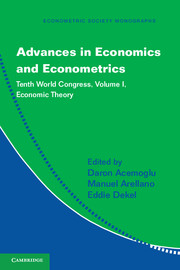Book contents
- Frontmatter
- Contents
- Contributors
- Preface
- I NONSTANDARD MARKETS
- II CONTRACTS
- III DECISION THEORY
- 7 Ambiguity and the Bayesian Paradigm
- 8 Temptation
- 9 Comments on “Behavioral” Decision Theory
- IV COMMUNICATION/ORGANIZATIONS
- V FOUNDATIONS: EPISTEMICS AND CALIBRATION
- VI PATENTS: PROS AND CONS FOR INNOVATION AND EFFICIENCY
- Name Index
- Miscellaneous Endmatter
9 - Comments on “Behavioral” Decision Theory
Published online by Cambridge University Press: 05 May 2013
- Frontmatter
- Contents
- Contributors
- Preface
- I NONSTANDARD MARKETS
- II CONTRACTS
- III DECISION THEORY
- 7 Ambiguity and the Bayesian Paradigm
- 8 Temptation
- 9 Comments on “Behavioral” Decision Theory
- IV COMMUNICATION/ORGANIZATIONS
- V FOUNDATIONS: EPISTEMICS AND CALIBRATION
- VI PATENTS: PROS AND CONS FOR INNOVATION AND EFFICIENCY
- Name Index
- Miscellaneous Endmatter
Summary
Introduction
The developments in decision theory summarized in the pair of excellent surveys extend the boundaries of orthodox rational-choice theory, incorporating types of behavior formerly considered less-than-fully rational and therefore outside the scope of the theory. More psychological phenomena are modeled nowadays as being consistent with utility maximization over some domain of objects of choice, and this means that they are treated as “rational” at some level. The method – which Lipman and Pesendorfer dubbed as “Krepsian,” after David Kreps's pioneering works in the late 1970s – is to start with an intuition (possibly backed by systematic observations) suggesting how choice behavior in general can be related to a certain “unconventional” psychological “force,” and to look for a specific domain of choice objects such that the force could be effectively elicited from revealed (complete and transitive) preferences over this domain.
For example, if the decision theorist is interested in behavioral manifestations of anxiety, then studying preferences over the domain of temporal lotteries can be illuminating because the decision maker's preference for early resolution of uncertainty may reveal the anxiety that this uncertainty generates (Kreps and Porteus 1978). Similarly, the domain of choice sets (i.e., “menus”) is appropriate for identifying the existence of unforeseen contingencies (Kreps 1979). Finally, the focus on Anscombe-Aumann acts (as opposed to Savage acts) in the ambiguity literature is entirely consistent with this methodology. Anscombe-Aumann acts are appropriate choice objects, not because of the technical simplifications they allow but rather because the distinction they make between “roulette” and “horse” lotteries enables us to elicit decision makers' attitudes to risk in distinction to their attitudes to uncertainty.
- Type
- Chapter
- Information
- Advances in Economics and EconometricsTenth World Congress, pp. 289 - 302Publisher: Cambridge University PressPrint publication year: 2013



